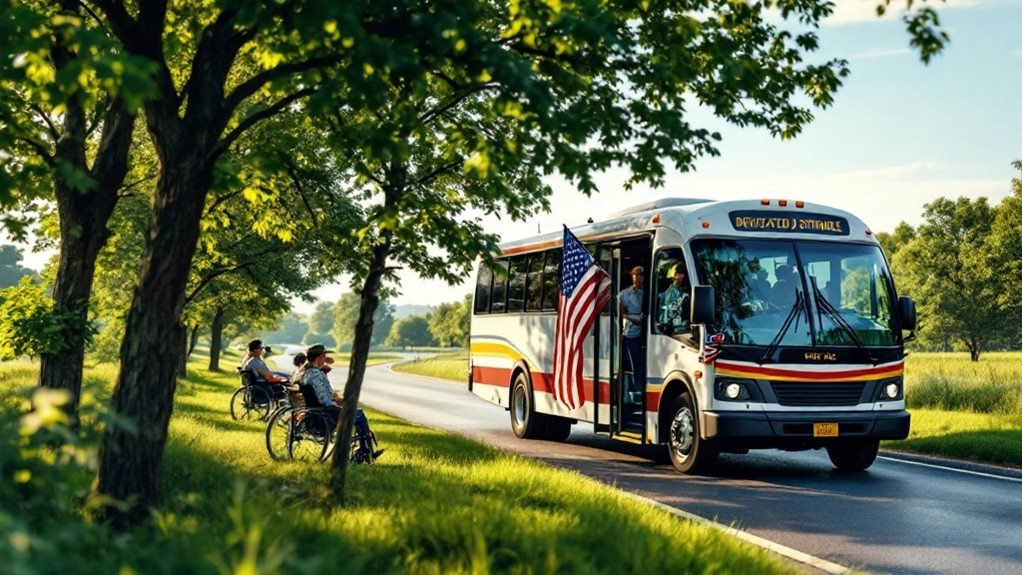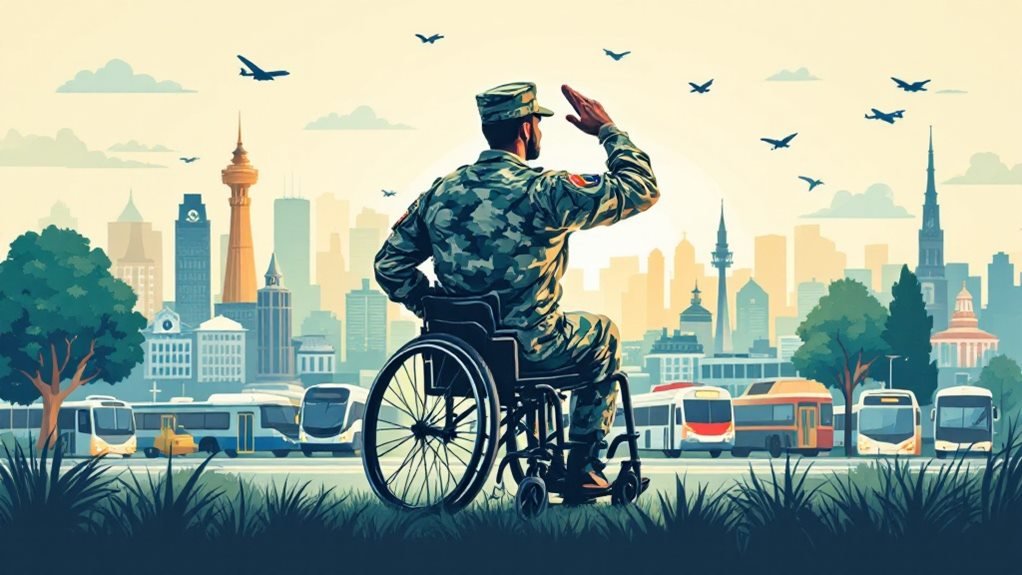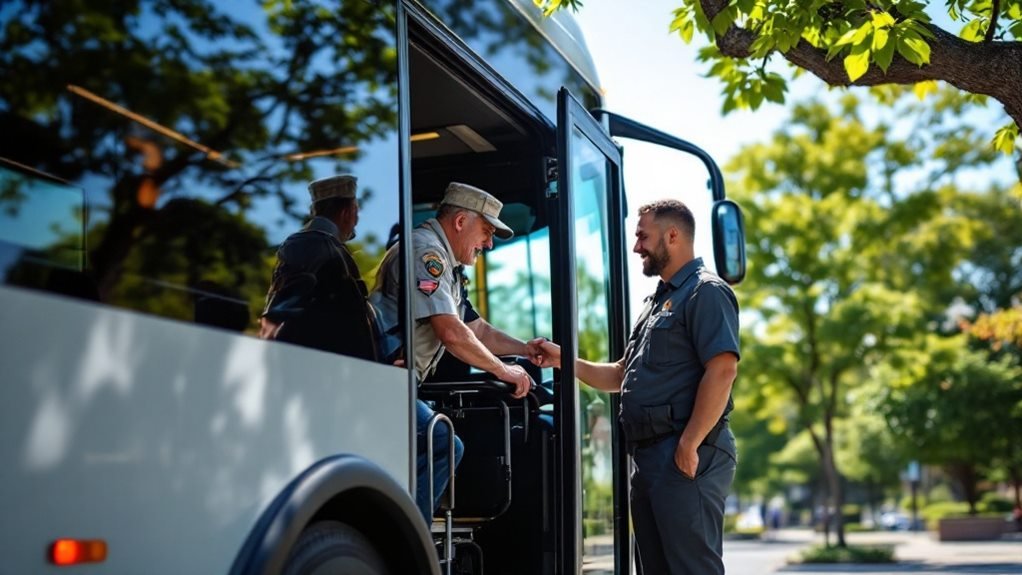To become a transportation provider for veterans, we start by acknowledging their unique mobility challenges, including the need for accessible vehicles and sensitivity to mental health considerations. We must meet eligibility criteria by securing proper insurance, valid licenses, and potentially passing background checks. It is crucial to complete necessary training programs, obtain permits, and establish safety protocols. Setting fair pricing and maintaining vehicle reliability are key. Partnerships with veteran organizations enhance service effectiveness and access to valuable resources. By engaging with the community and employing strategic marketing, we create trusted, supportive connections. Let's explore these steps in further detail.
Key Takeaways
- Obtain necessary certifications, including driver training and permits, to legally operate as a veteran transportation provider.
- Ensure vehicles are accessible, equipped with adaptive features for veterans' specific mobility needs.
- Conduct background checks and maintain compliance with local regulations for safe operation.
- Collaborate with veteran organizations to understand and address veterans' transportation needs effectively.
- Implement marketing strategies, including community engagement and digital outreach, to connect with the veteran community.
Understanding Veteran Transportation Needs
Understanding the unique transportation needs of veterans is essential to providing effective services. As a community committed to supporting those who've served, we must recognize that veteran mobility challenges are diverse and often complex. Many veterans may face physical disabilities due to service-related injuries, making it difficult for them to navigate traditional transportation systems.
Others might confront mental health challenges that can impact their ability to travel independently. Our goal is to guarantee that all veterans have access to reliable, convenient, and accessible transport options that cater to their specific needs.
To address these challenges, we need to explore a variety of accessible transport options. This includes vehicles equipped with wheelchair lifts, ramps, and other adaptive features that accommodate physical limitations.
Additionally, offering transportation services that are sensitive to the unique mental health needs of veterans is imperative. This might involve training drivers in understanding and effectively communicating with veterans who may experience anxiety or PTSD during travel.
Meeting Eligibility Criteria
To become a transportation provider for veterans, it's important to understand the eligibility criteria set forth by the relevant authorities. Our journey begins by gathering the necessary eligibility documentation. This often includes proof of insurance, vehicle registration, and a valid driver's license. Authorities may require us to pass background checks to guarantee the safety and security of the veterans we serve.
We'll also need to demonstrate our commitment to providing reliable and compassionate service.
Next, let's focus on defining our service area. This involves identifying the geographic regions we wish to cover. We should consider the needs of local veterans and the availability of services in those areas. By strategically selecting our service area, we can make sure we're reaching those who need us most while optimizing our resources.
Additionally, understanding local regulations and requirements for operating within our chosen service area is significant. Each region might've specific rules regarding transportation services, and adhering to these guarantees compliance and smooth operation.
Obtaining Necessary Certifications
Let's explore the essential certifications we need to serve veterans effectively.
First, we'll cover the required training programs that guarantee we meet the specific needs of our veteran passengers.
Next, we'll discuss the necessary licensing and permits that authorize us to operate legally and safely.
Required Training Programs
As we commence on the journey to become transportation providers for veterans, it's vital to understand the importance of required training programs and obtaining necessary certifications.
Our veterans deserve the utmost care and respect, which begins with making certain we're fully prepared and qualified. Driver training is an important component of this preparation. It equips us with the skills needed to safely operate vehicles tailored for veteran transportation, including specialized vehicles for those with disabilities.
Safety protocols are another significant aspect of our training. We must familiarize ourselves with procedures that guarantee the well-being of our passengers, taking into account any unique needs they might have.
This includes learning how to secure wheelchairs properly, assisting with boarding and disembarking, and staying updated on emergency response techniques.
Licensing and Permits
Steering through the labyrinth of licensing and permits is an essential step in our mission to serve veterans as transportation providers.
It's our responsibility to guarantee we comply with all necessary regulations to provide safe and reliable services. First, we must acquire a commercial driver's license (CDL) if required by our state, as this will often depend on vehicle specifications, such as weight and passenger capacity.
Understanding these specifications is critical, as they guide us in meeting the correct legal requirements.
Next, we'll need to address the insurance requirements. Adequate insurance coverage isn't only a legal necessity but also a moral one, guaranteeing our passengers are protected.
We should consult with an insurance professional to tailor our coverage to the specific needs of our service, factoring in the vehicle type and the scope of our operations.
Additionally, local permits may be necessary, depending on where we operate.
We should reach out to local transportation authorities to identify any additional certifications or permits required.
By meticulously maneuvering through these requirements, we honor our commitment to serving veterans with the dignity and care they deserve.
Let's embrace this challenge wholeheartedly and lead by example.
Setting Up Your Service
Setting up our service as a transportation provider for veterans requires thoughtful planning and a commitment to understanding their unique needs.
First, we must consider how we'll structure our service pricing. It's essential to guarantee that our rates are fair and transparent, reflecting the true value of our service while remaining accessible to veterans who might be on a fixed income. We can explore tiered pricing models or discounts for veterans to make our services more appealing and affordable.
Alongside pricing, vehicle maintenance is a key aspect of setting up our service. Confirming our vehicles are in top condition guarantees reliability and safety, which is paramount when transporting veterans to medical appointments or social engagements.
Regular maintenance checks, timely repairs, and cleanliness won't only extend the life of our vehicles but also build trust with those we serve.
Partnering With Veteran Organizations
Partnering with veteran organizations is a crucial step in enhancing our transportation service's reach and effectiveness. By aligning ourselves with these dedicated groups, we can better understand veterans' specific needs and tailor our services accordingly.
These partnerships aren't just about expanding our network; they're about creating a support system for those who've served our country.
Let's explore how we can engage in collaborative initiatives. Working closely with veteran organizations allows us to participate in joint efforts that directly benefit veterans. Whether it's coordinating transportation for medical appointments or community events, these initiatives help guarantee that veterans receive the support they deserve.
Additionally, they provide us with valuable insights into how we can improve and adapt our services.
In addition to collaborative initiatives, partnering with veteran organizations opens doors to funding opportunities. Many organizations have access to grants and resources specifically designated for veteran services.
By forming strong alliances, we can tap into these financial resources, allowing us to expand our services and reach more veterans.
Ultimately, our goal is to build meaningful relationships with veteran organizations, guaranteeing that our transportation services make a difference in the lives of those who've sacrificed so much.
Marketing Your Transportation Services
To effectively market our transportation services to veterans, we need to focus on targeted outreach strategies that address their specific needs.
Building referral networks with veteran organizations and community groups will help us establish trust and credibility in this community.
Targeted Outreach Strategies
Effectively marketing our transportation services to veterans requires targeted outreach strategies that resonate with their unique needs and experiences.
First, let's focus on community engagement. Building trust within the veteran community is essential. We can attend veteran-focused events, participate in community gatherings, and collaborate with local veteran organizations. By being present and engaged, we not only promote our services but also demonstrate our commitment to supporting those who've served.
Next, let's discuss digital outreach. An online presence is vital. We should create a user-friendly website and utilize social media platforms to connect with veterans. Sharing stories of how our services have positively impacted veterans can be powerful. These stories not only inform but also inspire, showing potential clients the tangible benefits of our transportation services.
Additionally, tailored messaging is important. We need to address the specific challenges veterans face, such as mobility issues or the need to access healthcare services. By speaking directly to these concerns, we show empathy and understanding, making our services more appealing.
Together, community engagement and digital outreach form a thorough strategy that effectively markets our transportation services to veterans, ensuring we reach those who need us most.
Building Referral Networks
Building a robust referral network is essential for expanding our reach within the veteran community and guaranteeing our transportation services are accessible to those who need them.
By connecting with organizations and individuals who share our mission, we can create a support system that thrives on collaboration and mutual benefit. Networking events are prime opportunities for us to meet like-minded professionals and veterans' organizations that can refer clients to our services.
These events allow us to share our mission, listen to the needs of the community, and establish meaningful partnerships.
Additionally, offering referral incentives can motivate individuals and organizations to spread the word about our transportation services. A simple yet effective incentive program could include discounts on future rides or gift cards for every referral that results in a successful booking.
This not only encourages engagement but also fosters a sense of community and support.
Let's also consider reaching out to local veteran service organizations, healthcare facilities, and community centers, as these entities are often in contact with veterans who require transportation services.
Ensuring Quality and Safety Standards
When it comes to ensuring quality and safety standards in transportation services for veterans, we must prioritize their well-being and comfort at every step. Quality assurance begins with implementing thorough safety protocols. These include regular vehicle inspections, driver background checks, and continuous training programs. By doing so, we guarantee that both our vehicles and personnel are prepared to handle any situation with professionalism and care.
We should also focus on creating a welcoming atmosphere for veterans. This involves training our staff to be empathetic and respectful, understanding the unique needs veterans may have. Listening is key; by being attentive, we can adapt our services to provide a supportive and reassuring experience.
Additionally, clear communication with veterans about safety measures and service expectations helps build trust. We can achieve this through detailed briefings before trips and ensuring that contact information is readily available for any questions or concerns.
In our pursuit to serve better, gathering feedback from veterans is invaluable. It allows us to refine our processes and uphold the highest standards.
Conclusion
So, there we have it! We've laid out the path to becoming a transportation provider for veterans, minus the superhero cape. Who knew meeting eligibility criteria could be so thrilling? While juggling certifications, partnerships, and marketing might not land us in a Hollywood blockbuster, it will guarantee our veteran heroes get the rides they deserve. Let's rev up those engines, aim for the stars, and remember: safety first, cape second! Happy transporting, fellow road warriors!



